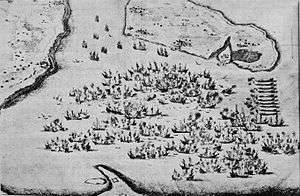Charles, Duke of Guise
Charles de Lorraine, 4th Duke of Guise (2 August 1571 – 30 September 1640) was the son of Henry I, Duke of Guise and Catherine of Cleves.[1]


Biography
He was born in Joinville, (Haute-Marne department), in the Champagne-Ardenne region of northeastern France. Originally styled the Chevalier de Guise, he succeeded as Duke of Chevreuse upon the death of his great-uncle Charles of Guise, Cardinal of Lorraine, a title he later resigned to his brother Claude.
After his father's assassination in 1588, he succeeded him as Duke of Guise, but was kept in prison in Tours for three years, escaping in 1591.[2] While the Catholic League had great hopes for him, and considered placing him on the throne, he declared his support for Henry IV of France in 1594,[3] for which Henry paid him four million livres and made him Governor of Provence.[4] In 1595, he captured Marseille from the Duc d'Épernon, who held it for the League.
He was later created Grand Master of France and Admiral of the Levant.
Falling into disfavor with Cardinal Richelieu for siding with Marie de' Medici, he withdrew to Italy in 1631.[5] His wife and younger children joined him in Florence, where the family was protected by the House of Medici. His sons François and Charles Louis died in Italy during these years of exile. Duke Charles himself died, at Cuna, in 1640. His widow and children (among them Marie, Mademoiselle de Guise) were permitted to return to France in 1643.
Family
On 6 January 1611 he married Henriette Catherine of Joyeuse (8 January 1585 – 25 February 1656).[6] They had:
- François (3 April 1612 – 7 December 1639), Prince of Joinville,[7] who died in Florence during the family's exile and was buried in the church of San Lorenzo and later reinterred at Joinville. He was deemed "the most accomplished prince of his day."
- Twin boys (4 March 1613 – 19 March 1613), who were very frail and sickly. They died on the same day.
- Henry II, Duke of Guise (1614–1664), Archbishop of Reims[7]
- Marie, Duchess of Guise (1615–1688)[8]
- A girl, called Mademoiselle de Joinville (4 March 1617 – 18 January 1618), who was born healthy but caught a cold in the winter of 1617 and died shortly thereafter.
- Charles Louis (15 July 1618 – 15 March 1637, who also died in Florence) and was buried at San Lorenzo and later at Joinville, styled Duke of Joyeuse
- Françoise Renée (10 January 1621 – 4 December 1682, Montmartre), Abbess of Montmartre[5]
- Louis, Duke of Joyeuse (1622–1654), also Duke of Angoulême[8]
- Roger (21 March 1624 – died 9 September 1653) called the Chevalier de Joinville and later the Chevalier de Guise, [8]Knight of the Order of Malta, died of fever at Cambrai and buried near his ancestors at Joinville.
Ancestry
| Ancestors of Charles, Duke of Guise | ||||||||||||||||||||||||||||||||||||||||||||||||||||||||||||||||||||||||||||||||||||||||||||||||||||||||||||||||||||||||||||||||||||||||||||||||||||||||||||||||||||||||||||||||||||||||||||||||||||||||||||||||||||||||||||||||||||||||||||||||||||||||||||||||||||||||||||||||||||||||||||||||||||||||||||||||||||||||||||||||||||||||||||||||||||||||||||||||||||||||||||||||||||||||||||||||||||||||||||||||||||||||||||||||||||||||||||||||||||||||||||||||||||||||||||||||||||||||||||||||||||||||||||||||||||||||||||||||||||||||||||||||||||||||||||||||||||||||||||||||||||||||||||||||||||||||||||||||
|---|---|---|---|---|---|---|---|---|---|---|---|---|---|---|---|---|---|---|---|---|---|---|---|---|---|---|---|---|---|---|---|---|---|---|---|---|---|---|---|---|---|---|---|---|---|---|---|---|---|---|---|---|---|---|---|---|---|---|---|---|---|---|---|---|---|---|---|---|---|---|---|---|---|---|---|---|---|---|---|---|---|---|---|---|---|---|---|---|---|---|---|---|---|---|---|---|---|---|---|---|---|---|---|---|---|---|---|---|---|---|---|---|---|---|---|---|---|---|---|---|---|---|---|---|---|---|---|---|---|---|---|---|---|---|---|---|---|---|---|---|---|---|---|---|---|---|---|---|---|---|---|---|---|---|---|---|---|---|---|---|---|---|---|---|---|---|---|---|---|---|---|---|---|---|---|---|---|---|---|---|---|---|---|---|---|---|---|---|---|---|---|---|---|---|---|---|---|---|---|---|---|---|---|---|---|---|---|---|---|---|---|---|---|---|---|---|---|---|---|---|---|---|---|---|---|---|---|---|---|---|---|---|---|---|---|---|---|---|---|---|---|---|---|---|---|---|---|---|---|---|---|---|---|---|---|---|---|---|---|---|---|---|---|---|---|---|---|---|---|---|---|---|---|---|---|---|---|---|---|---|---|---|---|---|---|---|---|---|---|---|---|---|---|---|---|---|---|---|---|---|---|---|---|---|---|---|---|---|---|---|---|---|---|---|---|---|---|---|---|---|---|---|---|---|---|---|---|---|---|---|---|---|---|---|---|---|---|---|---|---|---|---|---|---|---|---|---|---|---|---|---|---|---|---|---|---|---|---|---|---|---|---|---|---|---|---|---|---|---|---|---|---|---|---|---|---|---|---|---|---|---|---|---|---|---|---|---|---|---|---|---|---|---|---|---|---|---|---|---|---|---|---|---|---|---|---|---|---|---|---|---|---|---|---|---|---|---|---|---|---|---|---|---|---|---|---|---|---|---|---|---|---|---|---|---|---|---|---|---|---|---|---|---|---|---|---|---|---|---|---|---|---|---|---|---|---|---|---|---|---|---|---|---|---|---|---|---|---|---|---|---|---|---|---|---|---|---|---|---|---|---|---|---|---|---|---|---|---|---|---|---|---|---|---|---|---|---|---|---|---|---|---|---|---|---|---|---|---|---|---|---|---|---|---|---|---|---|---|---|---|---|---|---|---|---|---|---|---|---|---|---|---|---|---|---|---|---|---|---|---|---|---|---|---|---|---|---|---|---|---|---|---|---|---|---|---|---|---|---|---|---|---|---|---|---|---|---|---|---|---|---|---|---|---|---|---|---|---|---|---|---|---|---|---|---|---|---|---|---|---|---|---|
| ||||||||||||||||||||||||||||||||||||||||||||||||||||||||||||||||||||||||||||||||||||||||||||||||||||||||||||||||||||||||||||||||||||||||||||||||||||||||||||||||||||||||||||||||||||||||||||||||||||||||||||||||||||||||||||||||||||||||||||||||||||||||||||||||||||||||||||||||||||||||||||||||||||||||||||||||||||||||||||||||||||||||||||||||||||||||||||||||||||||||||||||||||||||||||||||||||||||||||||||||||||||||||||||||||||||||||||||||||||||||||||||||||||||||||||||||||||||||||||||||||||||||||||||||||||||||||||||||||||||||||||||||||||||||||||||||||||||||||||||||||||||||||||||||||||||||||||||||
References
- Collins 2017, p. 121.
- Bernstein 2004, p. 241.
- Tenace 2012, p. 305.
- Kettering 1986, p. 151.
- Munns, Richards & Spangler 2015, p. 135.
- Munns, Richards & Spangler 2015, p. xiv.
- Munns, Richards & Spangler 2015, p. 87.
- Spangler 2016, p. 272.
Sources
- Bernstein, Hilary (2004). Between Crown and Community: Politics and Civic Culture in Sixteenth-century Poitiers. Cornell University Press.CS1 maint: ref=harv (link)
- Collins, James (2017). "Dynasty Instability, the Emergence of the French Monarchical Commonwealth and the Coming of the Rhetoric of L'etat, 1360s to 1650s". In von Friedeburg, Robert; Morrill, John (eds.). Monarchy Transformed: Princes and their Elites in Early Modern Western Europe. Cambridge University Press. p. 87-126.CS1 maint: ref=harv (link)
- Kettering, Sharon (1986). Patrons, Brokers, and Clients in Seventeenth-century France. Oxford University Press.CS1 maint: ref=harv (link)
- Munns, Jessica; Richards, Penny; Spangler, Jonathan, eds. (2015). Aspiration, Representation and Memory: The Guise in Europe, 1506–1688. Ashgate Publishing.CS1 maint: ref=harv (link)
- Spangler, Jonathan (2016). The Society of Princes: The Lorraine-Guise and the Conservation of Power and Wealth in Seventeenth-Century France. Routledge.CS1 maint: ref=harv (link)
- Tenace, Edward Shannon (2012). "Messianic Imperialism or Traditional Dynasticism? The Grand Strategy of Philip II and the Spanish Failure in the Wars of the 1590s". In Andrade, Tonio; Reger, William (eds.). The Limits of Empire: European Imperial Formations in Early Modern World. Ashgate Publishing. p. 281-308.CS1 maint: ref=harv (link)
| Preceded by Charles I |
Duke of Chevreuse 1574–1606 |
Succeeded by Claude |
| Preceded by Henry I |
Duke of Guise Prince of Joinville Count of Eu 1588–1640 |
Succeeded by Henry II |
| Preceded by Henriette Catherine |
Duke of Joyeuse with Henriette Catherine 1611–1640 |
Succeeded by Louis |